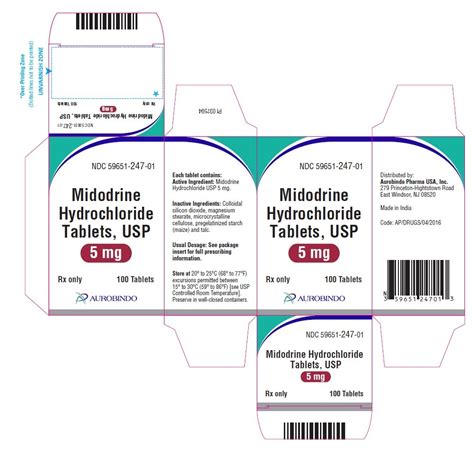Intro
Discover Midodrines benefits for orthostatic hypotension, including improved blood pressure regulation, reduced dizziness, and enhanced quality of life, exploring its uses, side effects, and treatment options.
The importance of understanding midodrine uses and benefits cannot be overstated, especially for individuals dealing with orthostatic hypotension. This condition, characterized by a sudden drop in blood pressure upon standing, can lead to dizziness, fainting, and a host of other symptoms that significantly impact one's quality of life. Midodrine, an alpha-adrenergic agonist, has emerged as a crucial medication in managing this condition. By exploring its uses and benefits, patients and healthcare providers can make informed decisions about its incorporation into treatment plans.
Orthostatic hypotension is a condition that affects a considerable number of people, particularly the elderly and those with certain medical conditions. The symptoms can range from mild to severe and include lightheadedness, weakness, blurred vision, and even fainting. The impact on daily life is substantial, as individuals may find themselves avoiding activities that trigger these symptoms, leading to a decrease in mobility and independence. Midodrine offers a therapeutic option that can mitigate these effects, thereby improving the patient's overall well-being and ability to engage in daily activities without fear of debilitating symptoms.
The mechanism of action of midodrine is rooted in its ability to constrict blood vessels, which increases blood pressure. This effect is particularly beneficial for individuals with orthostatic hypotension, as it helps to maintain adequate blood flow to the brain and other vital organs when standing. By understanding how midodrine works, healthcare providers can better explain its benefits to patients and set realistic expectations for its use. Furthermore, recognizing the potential side effects and interactions is crucial for safe and effective treatment. This comprehensive approach to midodrine therapy underscores the importance of a collaborative relationship between patients and healthcare professionals in managing orthostatic hypotension.
Introduction to Midodrine

Pharmacological Profile
The pharmacological profile of midodrine is characterized by its selective action on alpha-adrenergic receptors. This selectivity is crucial as it minimizes the risk of unwanted side effects that could be associated with non-selective adrenergic agonists. The metabolism and excretion of midodrine are also important considerations, as they influence the drug's half-life and the timing of its administration. Understanding these aspects is vital for optimizing the therapeutic regimen and ensuring patient compliance.Benefits of Midodrine

Improvement in Symptom Management
One of the primary benefits of midodrine is its ability to improve symptom management in patients with orthostatic hypotension. By increasing blood pressure, midodrine reduces the frequency and severity of symptoms such as dizziness and fainting. This improvement in symptom control allows patients to participate in activities they may have previously avoided due to fear of triggering an episode of orthostatic hypotension. The enhancement in mobility and the reduction in symptom burden contribute to a better quality of life.Administration and Dosage

Dosing Considerations
Dosing considerations for midodrine include the initial dose, dose titration, and maximum daily dose. Patients usually start with a low dose, which can be gradually increased based on their tolerance and response to the medication. The goal is to achieve a dose that effectively manages symptoms without causing undue side effects. Monitoring blood pressure regularly, both in the supine and standing positions, is crucial for adjusting the dose appropriately.Side Effects and Interactions

Monitoring for Side Effects
Monitoring for side effects is an integral part of midodrine therapy. Patients should be educated on the potential side effects and instructed to report any concerns promptly. Regular follow-up appointments allow healthcare providers to assess the patient's response to the medication, adjust the dose as needed, and address any side effects early on. This proactive approach helps in maintaining the safety and efficacy of the treatment.Conclusion and Future Perspectives

Emerging Trends and Research
Emerging trends and research in the field of orthostatic hypotension and its treatment with midodrine are focused on optimizing therapy and exploring new therapeutic targets. Advances in pharmacogenomics may allow for personalized treatment approaches, where the dosage and type of medication are tailored to the individual's genetic profile. Additionally, lifestyle modifications and non-pharmacological interventions are being studied for their potential to complement midodrine therapy and further improve patient outcomes.What is midodrine used for?
+Midodrine is used for the treatment of orthostatic hypotension, a condition characterized by a sudden drop in blood pressure upon standing.
How does midodrine work?
+Midodrine works by constricting blood vessels, which increases blood pressure. This effect helps to alleviate the symptoms of orthostatic hypotension.
What are the common side effects of midodrine?
+Common side effects of midodrine include piloerection, pruritus, and urinary retention. Less common but more serious side effects can also occur.
We invite readers to share their experiences or ask questions about midodrine and its use in treating orthostatic hypotension. Your input is invaluable in fostering a community that supports and educates individuals about this condition and its management. By engaging in this discussion, we can work together to improve awareness and promote better health outcomes for those affected by orthostatic hypotension.
